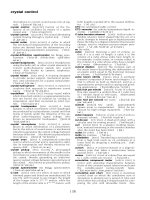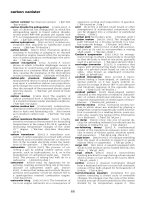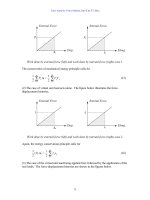Handbook of Lubrication Episode 1 Part 5 pdf
Bạn đang xem bản rút gọn của tài liệu. Xem và tải ngay bản đầy đủ của tài liệu tại đây (677.7 KB, 17 trang )
NUMERICALMETHODS IN HYDRODYNAMIC LUBRICATION
J. H. Vohr
INTRODUCTION
Analysis of the performance of fluid-film bearings involves the solution of Reynolds
equation, derived previously in the chapter on Hydrodynamic Lubrication (Volume II). For
an incompressible lubricant, the steady state form of this equation is
(1)
While there are many analytical solutions to this equation for relatively simple geometries,
the usual method of solution is by numerical analysis, employing either finite difference or
finite element techniques.
1-3
The following provides a brief description of these procedures.
FINITE DIFFERENCE SOLUTIONS
Assuming constant lubricant viscosity, Equation 1 can be rewritten
(2)
The purpose of finite difference approximations is to reduce a continuous differential
equation, such as Equation 2, to a series of algebraic equations that can be solved for the
pressure distribution P(x,y) for a known distribution of h(x,y) and µ(x,y).
First, the distribution of all functions in all coordinates concerned are replaced by samplings
at several discrete points. Usually the spacing between points along each coordinate axis is
chosen to be constant, but uneven spacing may be more suitable for some special applications.
The governing differential equations are then written at each point of the coordinate grid
with suitable approximations for the functions and their derivatives. Most common of such
approximations are central difference formulas applicable to a uniform grid spacing as shown
in Figure 1.
(3)
(4)
(5)
(6)
(7)
(8)
(9)
(10)
Substituting these approximations in Equation 2, one obtains the following algebraic
equation in the unknown pressure P(i,j), P(i + l,j); P(i – l,j), P(i,j + 1), and P(i,j –
1) at each i,j grid point.
Volume II 93
93_104 4/11/06 12:09 PM Page 93
Copyright © 1983 CRC Press LLC
major methods will be discussed here: relaxation, direct matrix inversion, and columnwise
influence coefficients.
Relaxation
This method reduces all equations in the system to equations in only one unknown only
which can be solved immediately. All other unknowns in each equation are considered to
be known and equal to some previously computed value. Therefore, an initial distribution
is guessed and then successively improved by solving the system of equations in one un-
known. As an example, consider the square inclined slider thrust pad shown in Figure 2.
For the given geometry, ∂h/∂x = Δh/Δx = 0.001 and ∂h/∂y
=
0 throughout the film.
Applying Equation 11 at the i = 2, j = 2 coordinate point and assuming μ = 0.01 Pa-
sec and U = 1000 cm/sec.
Volume II 95
FIGURE 2. Notation for inclined slider pad.
(14)
93_104 4/11/06 12:09 PM Page 95
Copyright © 1983 CRC Press LLC
Writing Equation 11 at the three remaining interior points yields four equations such as
Equation 14 in which P(i,j) is expressed in terms of its neighbors. Pressures on the boundaries
(i = 1, j = 1, i = 4, and j = 4) are set equal to zero. With this boundary condition
imposed, Equation 14 may be rewritten
P(2,2) = 1/4 [P(3,2) + P(2,3) ] + 3/8 10/0.03 P(3,2) −6/4 1/(0.03)
3
(15)
Similarly, at the i = 2, j = 3 grid point
P(2,3) = 1/4 [P(3,3) + P(2,2) ] + 3/8 10/0.03 P(3,3) −6/4 1/(0.03)
3
(16)
and so forth for i = 3, j = 2 and i = 3, j = 3.
Starting with some assumed initial distribution for the interior pressures P(i,j) [P(i,j) =
0 everywhere is an adequate choice], one can solve Equation 15 for P(2,2). This “updated”
value for P(2,2) may now be used in Equation 16, together with the initially assumed zero
for the rest of the pressures, to obtain an “updated” value for P(2,3). One proceeds in this
fashion up the i = 3 grid columns, solving for P(3,2) and P(3,3), always using the most
recently updated values of surrounding pressures when solving for P(i,j). Successive sweeps
through the finite difference grid continue until successive interior pressures P(i,j) converge
to a final distribution. Typically, 30 sweeps may be required for convergence.
Several improved procedures of applying relaxation methods exist such as “overrelaxa-
tion”, which strives to accelerate the convergence process by multiplying the change in
pressure from one sweep to the next by a factor such as 1.2. A drawback of relaxation
procedures is their proneness to numerical instability. This phenomenon sets in depending
on the value of the coefficients, and of the first guess distribution.
As seen in the example above, the equation written for point (i,j) is solved for P(i,j).
Therefore, the value of P(i,j) is corrected at each iteration by the influence of its immediate
neighbors. As a consequence, the influence of each point propagates one grid interval each
iteration and the number of iterations involved in achieving steady-state solutions is pro-
portional to the number of points on the longest side of the grid. In addition, the number
of operations is proportional to the total number of grid points N × M. Therefore, the total
time needed for converging to a steady-state solution is proportional to N
2
× M, where N
has been assumed to be larger than M. For computation speed, the relaxation method has
advantages over the others for large values of N and M. As a general rule, however, the
stability of a relaxation solution decreases when the number of grid points is increased.
Slowing the pace of the solution (“underrelaxation”) usually circumvents the problem but
obviates the speed advantages for large grids. Since relaxation requires minimum internal
computer capacity, this method still finds occasional use with a desk-top computer.
Direct Matrix Inversion
In this simple method, all equations are written together as a system.
Letting L = N × M,
a
11
q
1
+ a
12
q
2
+ … a
1L
q
L
= r
1
a
21
q
1
+ a
22
q
2
+ … a
2L
q
L
= r
2
. . . . . . .
a
L1
q
1
+ a
L2
q
2
+ … a
LL
q
L
= r
L
(17)
where
96 CRC Handbook of Lubrication
93_104 4/11/06 12:09 PM Page 96
Copyright © 1983 CRC Press LLC
Obviously, most of the “a’s” are zero. The system (Equations 17) may be written as in
matrix notation as
[ a ] { q } = { r } (18)
By methods such as Gaussian inversion, the problem can be solved as
{ q } = [ a ]
–1
{ r } (19)
Inversion of matrix [a] is performed by routines available at any computer installation.
If this method were economical in computation time, it would be the most desirable since
it solves the linear system of algebraic equations with a minimum of bookkeeping compli-
cations. Unfortunately, the computation time involved in performing the key matrix inversion
step grows proportionately to L
3
or M
3
× N
3
which is exorbitant except for very small
grids.
Columnwise Influence Coefficients
This method is similar to matrix inversion, but takes advantage of some features of the
system of equations. If we denote the j
th
column of unknown pressure as
{ P(i) }
j
i=1,M
then we can see by Equation 11 that the equations involving this j
th
column vector also
involve only the adjacent column vectors <P(i)>
j–1
and <P(i)>
j+1
. These equations can
be written in matrix form as
[ A ]
j
{ P }
j
+ [ B ]
j
{ P }
j–1
+ [ C ]
j
{ P }
j+1
= { R }
j
(20)
where [A]
j
, [B]
j
, and [C]
j
are matrices which are M × M in size, M being the total number
of grid points in the i direction, i.e., the “height” of each column vector <P> j. Matrices
[A]
j
, [B]
j
, and [C]
j
can be determined from Equation 11.
At the start of the bearing film, i.e., at j = 1, pressure<P>is known and equal to the
boundary pressure P
a
. Consequently, Equation 20 at j = 2, gives
[ A ]
2
{ P }
2
+ [ B ]
2
{ P
a
} + [ C ]
2
{ P }
3
= {R}
2
(21)
Since <P
a
> is a column vector, each element of which is the known boundary pressure
P
a
, this equation can be written in the form
{ P }
2
= [ E ]
3
{ P }
3
+ { F }
3
(22)
where
(23)
If next written at j = 3, Equation 20 will involve unknown column pressure <P>
2
,
Volume II 97
93_104 4/11/06 12:09 PM Page 97
Copyright © 1983 CRC Press LLC
<P>
3
, and <P>
4
. By using Equation 22 to eliminate <P>
2
from this equation, one can
obtain an equation containing only the unknown column pressures <P>
3
and <P>
4
. We
can write this equation formally like Equation 22, i.e.,
{ P }
3
= [ E ]
4
{ P }
4
+ { F }
4
(24)
By continuing this procedure, we can successively write equations of the form
{ P }
j–1
= [ E ]
j
{ P }
j
+ { F }
j
(25)
for all values of j from j = 3 to j = N. Moreover, Equation 26 also holds at j = 2 if we
define [E]
2
=
0 and <F>
2
= <P
a
>.
Substituting Equation 25 into Equation 20 we obtain
([ A ]
j
+[ B ]
j
[E]
j
) { P }
j
= [ C ]
j
{ P }
j+1
+{ R }
j
− [ B ]
j
{ F }
j
(26)
Comparing Equation 26 with Equation 25 we can deduce the recursion relationship for
determining [E]
j
and <F>
j
.
[E]
j+1
= –[T]
j
[C]
j
{F}
j+1
= [T]
j
( {R}
j
– [B]
j
{F}
j
)
[T]
j
= ([A]
j
+ [B]
j
[E]
j
)
–1
(27)
The solution procedure for determining the unknown column pressures <P>
j
goes as
follows:
1. Starting with the initial values [E]
2
= 0 and <F>
2
= <P
a
> , use the recursion
relationships (Equation 27) to determine [E]
j
and <F>
j
for all values of j from 2 to
N.
2. At the end of the bearing (j = N), set <P>
N
equal to the known boundary pressure
<P
a
> .
3. Use Equation 25 successively from j = N to j = 2 to determine all column pressures
<P>
j
.
While the matrices which must be inverted here are of the order M × M, in the direct
inversion method the matrix is of the order M × N. If M is chosen to be significantly
smaller than N, computation cost of the columnwise method will be significantly less than
that of the direct method.
A more detailed description of the columnwise solution method, including a discussion
of cyclical boundary conditions, is given in Reference 1.
Calculation of Flow and Power Loss
Once the discretized pressure field is obtained, quantities such as bearing flow and power
loss may be obtained from approximate finite difference expressions. For example, lubricant
flow per unit width in the direction of sliding at the i,j grid point would be evaluated by
the following central difference expression
(28)
98 CRC Handbook of Lubrication
93_104 4/11/06 12:09 PM Page 98
Copyright © 1983 CRC Press LLC
At the leading edge, i.e., at i = 1, a forward difference formula must be used
(29)
Similarly, a backwards difference formula must be used at the trailing edge.
Power loss is obtained by multiplying surface shear stress τ
s
, acting on the surface by
surface velocity. In finite difference form
(30)
Multiplying τ
S
U by ΔxΔy and summing over the entire i,j grid, will yield the bearing power
loss.
FINITE ELEMENTANALYSIS
An alternate approach for solving Reynolds’equation is use of finite element analysis.
Developed originally for use in structural analysis, this method has been finding increasing
favor in the analysis of fluid film bearings. The method is particularly advantageous for
complex film geometries since the elements into which the solution field is broken do not
have to be uniform or follow coordinate lines.
Descriptions of the finite element method are given by Reddi,
4
Booker and Huebner,
5
Allaire et al.,
6
and Hays.
7
In this present discussion, the method will be described in its
simplest form by solving for the pressure in a one-dimensional, step slider bearing following
the sequence presented by Reddi.
4
Reddi presents a proof that if a functional φ(P) is given by
(31)
integrated over the region R, comprising a lubricant film, then
δ
φ
(P) = 0(32)
if and only if Pis a solution of the incompressible lubrication problem. In Equation 31, µ,
h, and Pare the lubricant film viscosity, thickness, and pressure, respectively, is the
vector velocity of the bearing surface, and q represents the outflow flux of lubricant from
the region R in in.
3
/sec/in. (m
2
/sec/m) across the boundary C
2
.
In Equations 32 and 33 pressure Pis described by a set of functions which are continuous
over R and which satisfy prescribed boundary conditions. In the finite element method,
region R is broken up into small elements and the distribution of pressure Pover each
element is described by convenient interpolation functions particular to the element. For
example, triangular elements are convenient for two-dimensional solutions as shown in Figure
3a.
The most convenient interpolation function is a linear one, i.e., the pressure P
m
over the
m
th
triangular element is assumed to vary as
P
m
(x,y) = a
m1
+ a
m2
x + a
m3
y (33)
By evaluating pressure P
m
at the three vertices or nodes of each element, one can solve for
constants a
m1
, a
m2
, and a
m3
in terms of the three unknown node pressures P
m1
, P
m2
, P
m3
at
Volume II 99
93_104 4/11/06 12:09 PM Page 99
Copyright © 1983 CRC Press LLC
b and lengths ᐉ
1
and ᐉ
2
, respectively. Since P is a function of x only, the finite elements
are linear rather than triangular. The pressures of the nodes of element 1 are P
A
and P
B
while the pressures at the nodes of element 2 are P
B
and P
C
. Using a linear interpolation
function for the pressure distributions over elements 1 and 2
P
1
(x) = P
A
+ x/l
1
(P
B
– P
A
) (34)
P
2
(x′) = P
B
+ x′/l
2
(P
C
– P
B
) (35)
We can write these equations in the general matrix form used in Reference 4,
P
m
(x) =T
m
P (36)
where P
m
(x) represents the variation of P over element m. P represents the column vector
of the unknown node pressures
(37)
and T
m
represents the appropriate row vector relating P
m
(x) to P. In our simple example
T
1
= { (1 −x/l
1
)x/l
1
0 }
T
2
= { 0 (1 −x′/l
2
)x′/l
2
} (38)
By differentiating Equation 36, one obtains the gradient of P
m
(x). For two-dimensional
problems, the gradient would be a column vector, i.e.,
(39)
The matrix formed from differentiating the row vector T
m
first with respect to x and then
with respect to y is denoted as R
m
. In our case, ∂T
m
/
∂
y is zero so R
m
reduces to a row
vector, where
(40)
Since we now have expressions for P and P over each element m, the integral over R in
Equation 31 can be written as a summation of integrals over each element m. Using the
general notation of Reference 4, Equation 31 becomes
(41)
In our simple one-dimensional case, the element property term C
m
is purely the scalar
quantity h
m
3
/12µ and the velocity U
m
is simply the velocity U in the x direction. In the more
Volume II 101
93_104 4/11/06 12:09 PM Page 101
Copyright © 1983 CRC Press LLC
general two-dimensional case described in Reference 4, C
m
is a matrix and U
m
is a vector.
Equation 41 can be restated as
(42)
where K is the volumetric fluidity matrix, and V, H, and Q are the element flow, squeeze
film, and boundary flow column vectors, respectively, given by:
(43)
Let us now evaluate K, V, and Q for our example (H is zero for this steady-state case).
For elements 1 and 2, from Equation 41
(44)
(45)
Substituting these into the expression for K, integrating over each element, and then
summing over the elements:
(46)
For the element flow vector V,
(47)
102 CRC Handbook of Lubrication
93_104 4/11/06 12:09 PM Page 102
Copyright © 1983 CRC Press LLC
Substituting these into the expression for V, integrating over each element, and summing
(48)
Finally, for Q, flows q
1
and q
2
leaving the bearing per unit width at the leading and trailing
edge boundaries, respectively, are
(49)
Using expressions (Equation 38) for T
1
and T
2
, x = 0 at the leading edge boundary and
x′ = ᐉ
2
at the trailing edge:
(50)
Substituting these expressions into Equation 45 for Q, integrating along the leading and
trailing edge boundaries, and summing
(51)
Now, Equation 32 states that if the pressure P is a solution of the incompressible lubrication
problem, then δφ(P) = 0 over the region R
(52)
where P
i
are the unknown pressures at the nodes of the elements. Since δP
i
is an independent
variation, it follows that ∂ϕ/∂P
i
= 0 for each i. From Equation 42
(53)
or
(54)
Equation 54, in general, yields a system of simultaneous equations for the nodal pressures
P which may be solved by any of a number of established techniques. In our simple example,
Equation 54 becomes
(55)
Volume II 103
93_104 4/11/06 12:09 PM Page 103
Copyright © 1983 CRC Press LLC
To solve Equation 55, conditions must be supplied for boundary pressures P
A
and P
C
.
For the simplest case where P
A
= P
C
= 0, the set of three equations represented by Equation
55 reduces to the following single equation for P
B
.
(56)
The above example illustrates the steps involved in setting up the matrices and vectors
associated with a finite element solution. As such, it is intended to provide only a “flavor”
of how the method works. In this simple case, the answer could have been obtained more
easily by a less involved procedure, so our example does not illustrate the power of the
method. Numerical advantages the finite element method has over finite difference techniques
are discussed in Reference 4.
The numerical techniques described in the preceding pages may also be applied to solution
of the energy equation derived in the chapter on Hydrodynamic Lubrication (Volume II).
Application of the columnwise influence coefficient finite difference method to solving both
the pressure and energy equations for a tilting pad thrust bearing are given in Reference 8.
Application of the finite element method to solving for both the static and dynamic char-
acteristics of tilting pad and step journal bearings is provided in References 9 and 10.
REFERENCES
1. Castelli, V. and Shapiro, W., Improved method for numerical solutions of the general incompressible
fluid film lubrication problem, J. Lubr. Technol., Trans. ASME, 89(2), 211, April 1969.
2. Castelli, V. and Pirvics, J., Review of numerical methods in gas bearing film analysis, J. Lubr. Technol.,
Trans. ASME, 90, October 1968.
3. Castelli, V., Numerical methods, in MTI Gas Bearing Design Manual, Wilcock, D. F., Ed., Mechanical
Technology Inc., Latham, N.Y., 1972.
4. Reddi, M. M., Finite element solution of the incompressible lubrication problem, J. Lubr. Technol., Trans.
ASME, Ser. F, 91(3), 524, July 1969.
5. Booker, J. F. and Huebner, K. H., Application of finite elements to lubrication; an engineering approach,
J. Lubr. Technol., Trans. ASME, Ser. F, 24(4), 313, October 1972.
6. Allaire, P. E., Nicholas, J. C., and Gunter, E. J., Systems of finite elements for finite bearings, J.
Lubr. Technol., Trans. ASME, Ser. F, 99(2), 187, April 1977.
7. Hays, D. F., A variational approach to lubrication problems and the solution of the finite journal bearing,
J. Basic Eng., Trans. ASME, 81(1), 13, March 1959.
8. Castelli, V. and Malanoski, S. B., Method for solution of lubrication problems with temperature and
elasticity effects: application to sector, tilting-pad bearings, J. Lubr. Technol., Trans. ASME, 91, 634,
October 1969.
9. Nicholas, J. C., Gunter, E. J., and Allaire, P. E., Stiffness and damping coefficients for the five-pad
tilting pad bearing, ASLE Trans., 22(2), 113, April 1979.
10. Nicholas, J. C., Allaire, P. E., and Lewis, D. W., Stiffness and damping coefficients for finite length
step journal bearings, ASLE Trans., 23(4), 353, October 1980.
104 CRC Handbook of Lubrication
93_104 4/11/06 12:09 PM Page 104
Copyright © 1983 CRC Press LLC
HYDROSTATIC LUBRICATION
R. C. Elwell
INTRODUCTION
In contrast to the hydrodynamic bearings described earlier, hydrostatic bearings support
loads on fluid supplied from an external source, usually a pump, which feeds pressurized
fluid to the film. For this reason, these bearings are often called “externally pressurized”.
Hydrostatic bearings are used over a wide range of applications, from miniature high-
precision devices to large heavy masses, for the following reasons:
1.Friction is theoretically zero at zero rotational speed. Heavy objects can be moved
with small forces because the weight is “floated” on a fluid film.
2.Friction is repeatable. There is no mechanical contact between the parts, hence no
wear or burnishing of surfaces. This is important in machine tools and other precision
equipment, e.g., radar antennas.
3.Fluids with poor lubricating qualities can be used. Gases (nitrogen, helium, air), water,
and liquid metals (sodium) have all been used.
4.Large loads can be lifted on small bearing areas. In many machines, e.g., ore crushers,
axial space for journal bearings is limited. Acompact bearing can be used here, with
fluid pressures of the order of 56 MPa (8000 psi). Reference 1 describes such a bearing,
designed to accommodate local structural deflections.
5.High startup loads on hydrodynamic bearings can be relieved by hydrostatic pockets
built into their surfaces. These “oil lifts” are common in hydrogenerators and large
steam turbines.
In recent years, there have been a number of large-scale, low-pressure applications of the
basic principle. Among these are “air pallets” for handling materials, and Mile High Stadium
in Denver in which an entire grandstand with 21,000 seats slides back on hydrostatic water
films to convert the stadium from football to baseball.
BASIC THEORY
Almost any fluid may be used in a hydrostatic bearing but this chapter will discuss only
incompressible fluids (liquids) in laminar flow. Fluid compressibility and turbulence intro-
duce special problems in gas bearings and high speed applications. The literature on these
topics is abundant.
Load
Load is the product of pressure and bearing area:
w = k(P
p
– P
o
) A(1)
The constant k is less than 1 and is a function only of the bearing geometry. One major
method of analysis
2
uses a “load coefficient” (a
f
) for the same purpose. The constant may
be thought of as the efficiency of the design in using the recess pressure to support the load.
For the geometry in Figure 1 for instance, k is approximately equal to (a – b)
2
/a
2
and A
= a
2
. The load as a function of supply pressure for this bearing is therefore:
Volume II 105
Copyright © 1983 CRC Press LLC
For the bearing in Figure 1, w
_
~(a – b) and ᐉ
=
b. In most applications, P
o
will be
atmospheric ambient pressure; some nuclear coolant pumps, however, have hydrostatic
journal bearings in which P
o
is of the order of 14 MPa (2030 psi), and P
p
is only slightly
higher. Calculating performance of such a bearing requires that the fluid viscosity be corrected
for pressure.
If Equation 3 is applied to a rectangular slot, for example the gap over one of the lands
in Figure la, the pressure drops linearly along the distance b (Figure 1c). Integration of the
pressure distribution over the area Agives the load capacity W. An especially important
aspect of Equation 3 is its sensitivity to the film thickness (h). As a practical matter, this
limits the separation between the moving and fixed parts of most bearings. The flow rate
usually becomes prohibitively high when the film is thicker than about 0.1 mm (0.004 in.).
Power
Power required to supply fluid to the bearing is given by:
H = QP
S
/
η
(4)
Ordinarily the power consumption of a hydrostatic bearing system is not large enough to
be important. Occasionally it becomes a problem because most of the pump power is
converted to heat when the fluid pressure is expended in the bearing. This can be serious
in high-precision applications such as astronomical telescopes and machine tools.
In the hydrostatic steadyrest of a large lathe, for example, a bearing with a geometry
resembling Figure 1 supports a heavy steel forging near midspan. The dimensions are a =
100 mm (3.94 in.) and b = 25 mm (0.98 in.). Oil is supplied at a rate of 0.025 l/sec (0.4
gpm) and a supply pressure of 56 MPa (8000 psi) by a fixed-displacement pump with an
efficiency of 0.5. The oil has a specific heat of 890 J/l(3.2 Btu/gal). From Equation 4, the
input power is calculated in SI units as follows:
H = 0.025 (56 × 10
6
)/1000 (0.5) = 2800 watts
In customary U.S. units, the power calculation would be:
H = 0.4(231)(8000)/60(12)(550)(0.5) = 3.73 hp
If all this power is converted to heat in the small oil flow, the resulting temperature rise
of the fluid would be 69°C (124°F). With a reservoir temperature of 38°C (100°F) this would
result in an oil temperature of 107°C (224°F) leaving the bearing. This local flow of hot oil
can cause a “hot spot” on the object being supported. In the lathe application, much of the
heat is absorbed by the rotating forging and is distributed by conduction and radiation. In
stationary applications local heating can cause distortions which may interfere with supporting
the load.
It is possible to minimize the power consumption with a rotating load because friction
(shear) losses come down and pump losses go up as the film thickness increases. The simple
case of a flat thrust bearing is given in Reference 6. Amore general discussion of optimizing
for minimum loss is given in Reference 3, based upon the parameter S
H
developed by Rowe
et al.
4
In applications sensitive to bearing heating, either of the above analytical methods
may be applied.
Flow Restrictors
Most hydrostatic thrust bearings use more than one pocket in order to resist misalignment
or off-center loads (Figure 2). (Journal bearings have many pockets distributed around their
Volume II 107
Copyright © 1983 CRC Press LLC
(5)
Constant Flow
Q
k
= a constant
(6)
Multiple gear pumps, mechanically coupled together, are commonly used for supplying
constant flow to several pockets at once. Each pump supplies a single pocket. Single-pump
systems with a constant flow valve in each lineare also used.
Capillary Tube
(7)
Equation 7 emphasizes one of the difficulties in using capillary tubes: slight variations in
the bore anywhere along the length are serious because of the fourth power
exponent.Furthermore, d
c
cannot be measured except at the ends.
Restricted bearings are analyzed by equating the inflow through the restrictor (Equations
5 to 7) to the outflow from the bearing (Equation 3). The resulting equation is solved for
the pocket pressure as illustrated in the next section.
THRUSTBEARINGS
Single Acting
Analysis of the circular thrust bearing with a central pocket (Figure 3) is available from
several sources
6,7
and has been verified in experiments.
8
Integration of the pressure distri-
bution in this bearing gives the load as a function of pocket pressure:
(8)
Equation 3 written for this geometry gives the flow.
(9)
Arestrictor in the supply line forces the bearing flow to assume the characteristic of the
restrictor. Equations 5 to 7 result in the flow-vs load relations illustrated in Figure 4 since
the pocket pressure in these equations is a linear function of load (Equation 8). By equating
each restrictor flow equation with the flow equation for this bearing (Equation 9), load
capacity expressions can be derived as below.
Orifice Restriction
(10)
Constant Flow
(11)
Volume II 109
Copyright © 1983 CRC Press LLC
FIGURE 5. Effect of restrictor type on stiffness of a thrust bearing (Reference 8).
FIGURE 6. Double-acting thrust bearing.
Volume II 111
Copyright © 1983 CRC Press LLC
FIGURE 7. Bearing pad coefficients for annular thrust pad bearing. Annular recess is
centrally located within bearing width (R
1
+ R
4
= R
2
+ R
3
). Curve for a
f
applies to
all R
1
/R
4
ratios. (Reproduced from Rippel, H. C., Cast Bronze Hydrostatic Bearing
Design Manual, Courtesy of Cast Bronze Bearing Institute, Chicago.)
From Figure 7 for annular thrust pad bearings:
112 CRC Handbook of Lubrication
Bearing A Bearing B
mm (in.) mm (in.)
R
1
100 (3.94) 50 (1.97)
R
2
120 (4.72) 70 (2.76)
R
3
180 (7.09) 180 (7.09)
R
4
200 (7.87) 200 (7.87)
k
v
= Flow, ᐉ/sec (gpm) 0.30 (4.76) 0.45 (7.13)
R
1
,/R
4
1/2 1/4
(R
3
– R
2
)/R
4
− R
1
) 0.60 0.73
Copyright © 1983 CRC Press LLC
Values of β(Equation 21 of Reference 2) are calculated over a range of loads for each
bearing. Performance coefficients for film thickness, pump power, stiffness and flow are
then taken from Figure 8. In a constant-flow bearing, pump power is proportional to load
so k
H
equals β. Film thickness coefficients over the range of loads in this example are as
follows:
Film thickness is calculated from the following relation from Reference 2:
The load capacity for each bearing is an inverse function of the film thickness cubed. When
the load increases to the value at which the pocket pressure reaches the supply pressure, the
calculated film thickness becomes indeterminate. This happens at 60.3 kN on bearing A
and 82 kN on bearing B. Pump power (neglecting efficiency) is calculated from:
To find the total power required, the calculated values must be divided by the pump efficiency
(of the order of 0.5 to 0.9 for most gear, vane, and piston-type pumps).
Combining the individual bearing performances curves gives the results shown in Figure
9 for the overall assembly. Figure 9a shows that the total usable load capacity is about +70
to –50 kN and that the rotor would move a distance of 0.26 mm (0.010 in.) between these
loads. Power loss of the combined bearing varies from 70 to 360 W(Figure 9b).
JOURNALBEARINGS
Acommon arrangement for a full journal bearing with six pockets is shown in Figure
10. The bearing is in a housing with an annular groove supplying fluid to all orifices. With
the load downward as in Figure 10, the pressure in the bottom pocket (P
L
) rises, by Equation
1. The orifice feeding the top pocket causes the pressure there (P
u
) to go down as its flow
increases. Analysis of hydrostatic journal bearings is more complex than for thrust bearings
because the film thickness is not generally uniform over the individual pads and the direction
of load is usually not limited.
A wide range of geometries is possible. Reference 9 presents design charts for four-pocket
journal bearings loaded in the direction of a pocket only. The same method was extended
Volume II 113
Bearing A Bearing B
a
f
(Load coeff.) 0.80 0.87
q
f
(Flow coeff.) 10.0 7.5
H
f
(Power coeff.) 12.4 8.6
β = W/a
f
A
p
P
s
16.58 × 10
−6
W 12.2 × 10
−6
W
Bearing A Bearing B
W, N
β
k
h
β
k
h
82,000 — — 1.00 1.00
70,000 — — .85 1.06
60,300 1.00 1.00 .74 1.11
50,000 .83 1.07 .61 1.19
30,000 .50 1.26 .37 1.41
10,000 .17 1.80 .12 2.05
Copyright © 1983 CRC Press LLC









